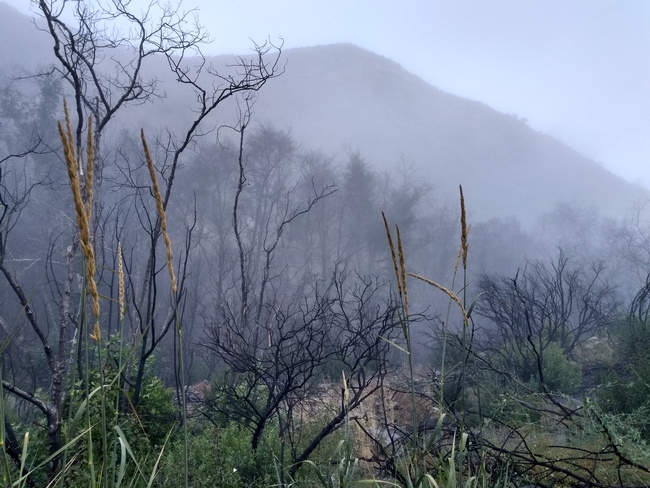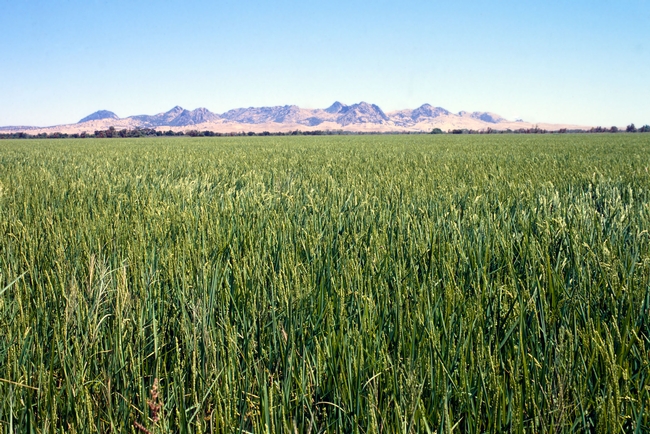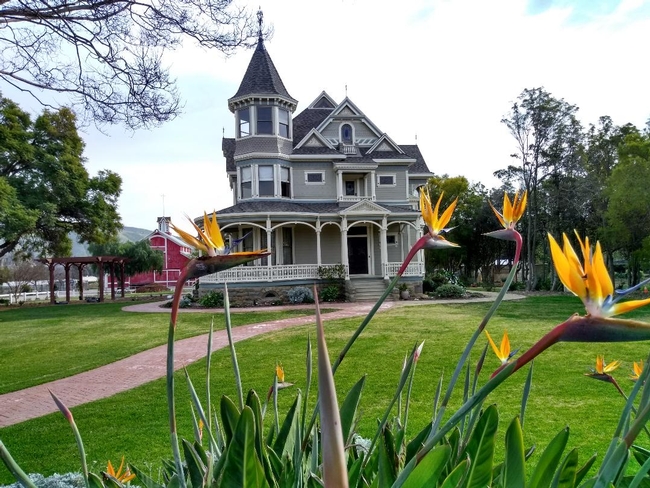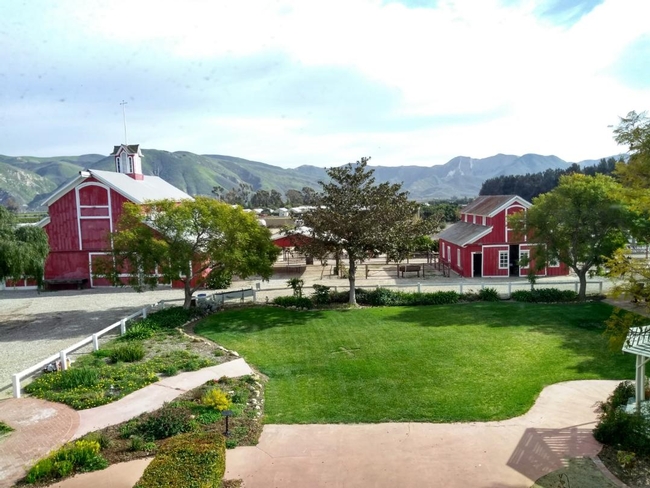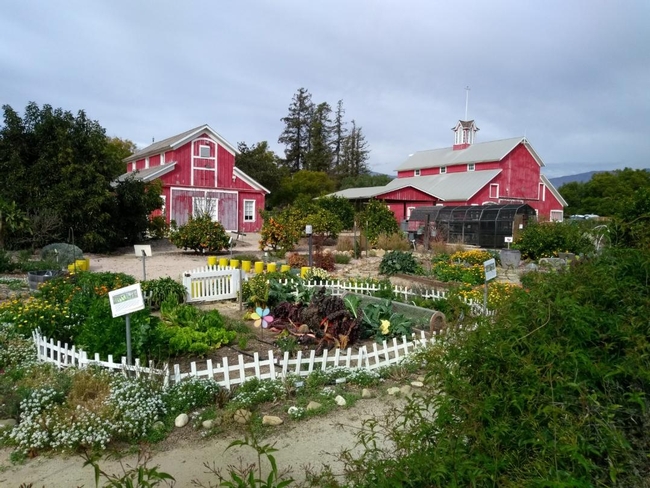Posts Tagged: agricultural research
How will climate change affect Southern California?
UC Thelma Hansen Fund to host climate webinar series, April 27-29
Members of the public are invited to attend a free webinar series discussing the effects of climate change on Southern California. At the three-day webinar Climate Change: What Does It Mean for Southern California?, UCLA climate scientist Daniel Swain and UC Agriculture and Natural Resources scientists will discuss climate changes anticipated, impacts on agriculture, wildfire risk and how to prepare for it, and ways to communicate about climate and to build resilience in communities.
“We are hearing a lot about climate change, but it can be difficult for the average person to figure out what it means for where they live and to understand the science behind it,” said Annemiek Schilder, director of UC Cooperative Extension in Ventura County and UC ANR Hansen Agricultural Research and Extension Center.
Topics of discussion include drought, adaptation for agriculture, fire management on rangelands and wildland-urban interface areas, and how UC Climate Stewards might improve climate understanding and empower community-level stewardship.
“All of us need to be better informed about this new reality and know how to respond to it,” said Schilder, who is organizing the event. “For Southern California, as a region with intense agricultural production and huge urban populations living in proximity to the coast, climate change could have devastating impacts. One of my favorite Latin sayings applies: Serius est quam cogitas – it is later than you think!”
Although residents may be concerned about climate change, they may not know what to do. The scientists will offer suggestions.
“People may feel powerless in the face of something that is happening on a global scale, but there are indeed things that can be done by individuals to mitigate the effects and to build resilience in the face of small and large disasters,” Schilder said. “In fact, doing nothing has a huge cost associated with it. Think of the economic damage already incurred by climatic extremes in recent years and the costs associated with possible future waves of climate refugees coming to the U.S.”
Registration for the webinar series, which is sponsored by the UC Thelma Hansen Fund, is free. To register and see the agenda and speaker biographies, visit http://ucanr.edu/hansensocalclimate.
Speakers include
- Daniel Swain, Ph.D., climate scientist, UCLA Institute of the Environment and Sustainability – Climate Change in California: A Drier or Wetter Future—or…Both?
- Sarah-Mae Nelson, M.S., UC Climate Stewards academic coordinator – UC Climate Stewards: Fostering Resilience in California Communities and Ecosystems
- Tapan Pathak, Ph.D., UC Cooperative Extension specialist in climate adaptation in agriculture, UC Merced – Climate Change Trends and Impacts on Agriculture in California and Ventura
- Ben Faber, Ph.D., UCCE soils, water and subtropical crops advisor, Ventura County – Heat, Wind, Freeze, Wind, Repeat
- Nicki Anderson, UCCE community education specialist, Ventura County – Overview of the Healthy Soils Program
- Max Moritz, Ph.D., UCCE wildfire specialist, Bren School of Environmental Science & Management, UC Santa Barbara – How Can We Address the Growing Wildland-Urban Interface Problem in California?
- Matthew Shapero, M.A.,UCCE livestock and range advisor, Ventura and Santa Barbara counties – Fire and Rangelands: Impacts on Ventura County Livestock Agriculture Counties
- Sabrina Drill, Ph.D., UCCE natural resources advisor, Ventura and Los Angeles counties – SAFER, Sustainable and Fire-Resistant Homes & Landscapes
If you missed the "Climate Change: What does it Mean for Southern California" webinars, watch the recordings:
April 27 https://youtu.be/8zfn3aaUAv0
April 28 https://youtu.be/dKlKk8sqoaE
April 29 https://youtu.be/2oh82L_wnTw
Report finds 10 to 1 return on investment in international agricultural research
Society gains $10 in benefits, on average, per $1 invested in international agricultural research and development, according to a new report released today (Oct. 14, 2020) by the Supporters of Agricultural Research (SoAR) Foundation.
“This report shows that international agricultural R&D, of the type that drove the Green Revolution, continues to generate a fantastic rate of return and that we have not been investing nearly enough in the types of agricultural R&D undertaken by the CGIAR,” said Julian M. Alston, distinguished professor of agricultural and resources economics at UC Davis and coauthor of “The Payoff to Investing in CGIAR Research.”
Formerly called the Consultative Group on International Agricultural Research, CGIAR is the world's largest global agricultural research network. The report found that CGIAR investments of roughly $60 billion in present value terms have generated a benefit-cost ratio of 10 to 1 over the past five decades.
“The same is true of agricultural R&D undertaken by U.S. land grant universities,” Alston said. “Not only does investing in this kind of R&D make great economic sense, with benefit-cost ratios of 10:1 and more, it saves lives and livelihoods for the poorest of the poor around the world, and reduces pressures on the natural resource base.
“In spite of this evidence, rather than ramping up funding, in the United States and the other high-income countries, we are seeing a decline in real funding support for public agricultural R&D and a decline in donor funding support for R&D undertaken by the CGIAR.”
It can take many years for the investment to pay off, from research and development to farmers applying new practices, planting new crop varieties and adopting new technology. Not investing in research will make it harder for farmers to produce the food needed while meeting the challenges posed by weather, pests, political strife, policy risk and market risk.
“Agricultural R&D is slow magic,” Alston said. “The costly consequences of today's policy mistakes may take some time to become apparent, but then we will have to live with them for a long time.”
Alston's coauthors on the report are Philip G. Pardey, professor of science and technology policy and director of global research strategy at the University of Minnesota, and Xudong Rao, assistant professor of agribusiness and applied economics at North Dakota State University. SoAR commissioned this work to examine the benefit-cost ratio of CGIAR investments.
“This work by esteemed economists exemplifies the continued need for increased investment in agricultural research across the globe,” said Thomas Grumbly, president of SoAR. “Farmers everywhere need new innovations to be able to adapt to the effects of climate change, while still feeding their communities and the world.”
Established in 1971, CGIAR comprises 15 research centers working under One CGIAR mandate to reduce poverty, enhance food and nutrition security, and improve natural resources. CGIAR's early work included developing high-yielding wheat and rice varieties, which is credited with spurring the Green Revolution and saving a billion lives primarily in Asia where many people were on the brink of starvation. Today, CGIAR focuses on ending hunger by 2030 through science to transform food, land and water systems in the climate crisis.
This report provides a strong economic investment case for funding partners as they consider future investments in international agriculture research and development. With a strong presence and long-term partnerships in developing countries, CGIAR is uniquely positioned to further create and develop needed innovations. Additional investments in CGIAR research would continue to yield dramatic returns on investment and benefits for poor communities, particularly in Africa and South Asia where smallholder farmers and local food systems are most vulnerable.
SoAR strongly encourages governments and foundations to accelerate their funding of CGIAR to strengthen smallholder agriculture and protect food systems for future generations.
To read the full report, visit https://supportagresearch.org/assets/pdf/Payoff_to_Investing_in_CGIAR_Research_final_October_2020.pdf. For key findings, visit https://supportagresearch.org/assets/pdf/soar_cgiar_key_findings_final.pdf.
Faulkner Farm for sale as UCCE seeks larger research acreage in Ventura County
The historic Faulkner Farm, a 27-acre farm near Santa Paula, is for sale. The property, which houses the UC Hansen Agricultural Research and Extension Center, is listed at $3.7 million by the University of California Agriculture and Natural Resources.
The property on the corner of Telegraph Road and Briggs Road includes a 126-year-old Queen Anne Victorian house, a 134-year-old large red barn and a smaller barn built in 1982 for a Budweiser commercial. An orchard features an extensive collection of avocado varieties as well as a collection of tropical and sub-tropical trees including various citrus, banana, guava, mango, passion fruit, persimmon, papaya and fig.
UC acquired the Faulkner Farm in 1997, under the leadership of Larry Yee, who was director of Cooperative Extension in Ventura County at the time. The purchase was made with an endowment from Saticoy farmer Thelma Hansen, who passed away in 1993, for agricultural research and education activities in Ventura County.
Due to increasing maintenance costs for the historical buildings at Faulkner Farm and limited acreage for agricultural research, the Hansen Advisory Board along with agricultural stakeholders in the county recommended that UC ANR divest all or part of the property to honor the terms of the endowment. For over a decade, previous boards have recommended the sale to redirect the funds from maintenance of the historical landmark to support research and outreach for better fulfillment of the directives of the UC Cooperative Extension mission and enhance service to the Ventura County community.
“Now, more than ever before, we need to really expand our ability to find solutions for the challenges that agriculture faces: pests, diseases, climate change and more,” said Glenda Humiston, University of California vice president for agriculture and natural resources. “Enhancing research is critical to the future of agriculture for this region.”
The university will lease back a portion of the land for 18 months to complete active research projects and allow for continued UC Master Gardener Program activities at the site during the transition to the new location for its UC Hansen Agricultural Research and Extension Center.
“We are committed to having a UC Research and Extension Center in Ventura County, with more acreage to facilitate research on a wider range of crops and cropping systems, and better facilities for research and education,” said Mark Lagrimini, UC ANR vice provost of research and extension.
UC ANR is currently seeking a new location in the county.
“We are looking for 40 to 70 acres on the Oxnard Plain, ideally near potential partners and collaborators and suited for row and permanent crops,” said Annemiek Schilder, director of UC Cooperative Extension in Ventura County and the Hansen Agricultural Research and Extension Center.
“I am greatly saddened to learn that the University of California has decided to sell the Faulkner Farm, site of the Hansen Agricultural Center,” said Yee, the former director of UCCE in Ventura County and UCCE advisor emeritus. “In the beginning, we had every hope that the center would grow and prosper and serve both the needs of the agricultural and larger communities well into the future.”
Research at the facility focuses on improving crop productivity, irrigation, biocontrol of pathogens and pests, novel pruning techniques, and the introduction and evaluation of promising crop commodities. Additional research activities focus on issues in small-scale urban agriculture and organic farming.
UCCE advisors extend research results to local growers during field days and workshops at the site. Master Gardener volunteers maintain a demonstration garden, where they offer workshops for community members. Year-round 4-H agricultural literacy programs for students in grades K-12 include farm field trips, classroom outreach, an after-school Student Farm, and a Sustainable You! Summer Camp. The students learn about Ventura County agriculture, nutrition, cooking and sustainability.
“The Faulkner Farm has been such an important landmark and has made invaluable contributions to the life and well-being of the community,” Yee said. “Countless families, school children, teachers, Master Gardeners, researchers and other scientists have passed through its gates to enjoy learning about the importance of agriculture, how things grow and all the interrelationships between healthy soil, food and humans.”
Sales of property owned by the Regents of the University of California are governed by The Stull Act, which requires a sealed bid process. Bids are scheduled to be opened and reviewed in mid-November by the university.
UC research could help farmers face droughts worldwide
Sorghum is not only a potential drought-tolerant crop for the San Joaquin Valley, it also presents the opportunity for scientists to understand the mechanism behind drought tolerance at the genetic level, said UCCE sorghum specialist Jeff Dahlberg in a segment on ABC 30 Action News.
Reporter Cristina Davies spent an hour and a half at the UC Kearney Agricultural Research and Extension Center in Parlier during the sorghum harvest to learn about the potential of sorghum research.
"If we can elucidate the genetics behind (drought tolerance), what we believe is we can use those genetics to see if the genetics are available in corn, or in rice, or in wheat," Dahlberg said. "I think the genes may be there. We just don't have the tools yet to search for the genes in those crops."
Conducting drought-tolerance research in California is ideal because the summer is typically devoid of rain. Researchers can control exactly how much water is applied to each sorghum plot. The research has revealed more than 100 genetic markers that may confer drought tolerance.
"We've been really thrilled with the data that's been coming out of this. Like most research, we are learning so many things we don't understand," Dahlberg said.
The research is being conducted in collaboration with the USDA's Agricultural Research Service research center, which is across the street from Kearney. USDA research scientist Devin Coleman-Derr was present for the sorghum harvest.
"Like humans take probiotics, there may be a use for microbes in sort of promoting better and better yields in the field," Coleman-Derr said.
The 330-acre UC Kearney Agricultural Research and Extension Center is the University of California's largest off-campus agricultural research facility.
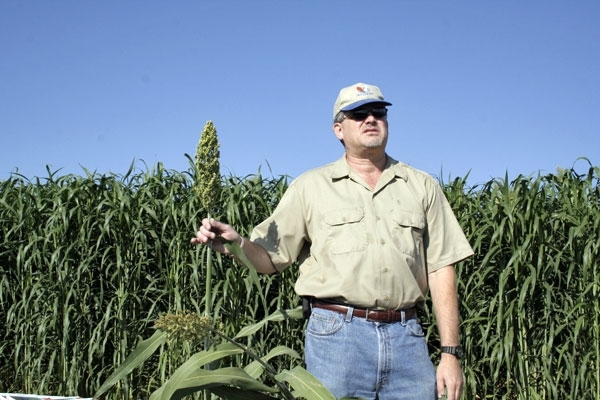
UCCE specialist Jeff Dahlberg studies sorghum at the UC Kearney Agricultural Research and Extension Center in Parlier.
Drone technology on display at UC research center

“The intent of this workshop is to start bringing the knowledge about unmanned aerial systems to the University of California Agricultural and Natural Resources division and the public at large,” said Sean Hogan, coordinator of Informatics Geographic Information Systems for UC ANR. “There is so much curiosity about it right now, it's a growing industry and there is a lot of concern and controversy about the misuses on it.”
The article said the UC system now has the green light to begin using drones. Hogan is holding workshops throughout the state to share his expertise with UC ANR employees and members of the community.
Desert Research and Extension Center director Jairo Diaz said the workshop was important because participants were able to see a demonstration of how the technology works and how it can be applied to the projects and research they are currently working on.
“These workshops that give growers and stakeholders can use in the area are very important because tech like this can help in the near future help find out different types of issues on the field like management of nutrients, water and find out to improve management of field,” Diaz said.
At the UC Kearney Agricultural Research and Extension Center last week, technicians tested a drone that will be used throughout the summer to collect growth data on 600 varieties of sorghum begin produced under different irrigation regimens. With imaging and lidar, the drone collects information on leaf area and biomass in half an hour that would take a full day for a person in the field.
Read more about the sorghum research at Kearney here.
